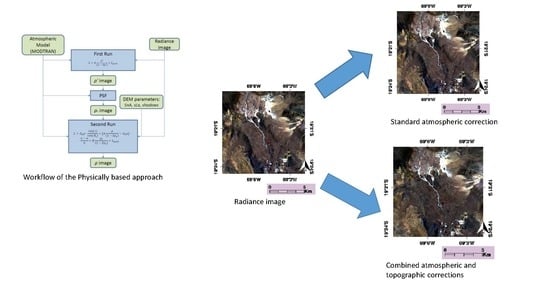Physically Based Approach for Combined Atmospheric and Topographic Corrections
Abstract
:1. Introduction
2. Methods
2.1. Physically Based Model
2.2. MODTRAN Simulation
2.3. Environment Functions
2.4. Algorithm Flow
3. Data and Test Cases Description
3.1. Appennino Lucano
3.2. Andes, Parinacota
3.3. Reggio Calabria
4. Results and Discussion
4.1. MODTRAN Test
4.2. Appennino Lucano
4.3. Andes, Parinacota
4.4. Reggio Calabria Test Case
5. Conclusions
Author Contributions
Funding
Acknowledgments
Conflicts of Interest
References
- Guanter, L.; Del Carmen, M.; Sanpedro, G.; Moreno, J. A method for the atmospheric correction of ENVISAT/MERIS data over land targets. Int. J. Remote Sens. 2007, 28, 709–728. [Google Scholar] [CrossRef]
- Acito, N.; Diani, M. Unsupervised atmospheric compensation of airborne hyperspectral images in the vnir spectral range. IEEE Trans. Geosci. Remote Sens. 2018, 56, 2083–2106. [Google Scholar] [CrossRef]
- Santini, F.; Alberotanza, L.; Cavalli, R.M.; Pignatti, S. A two-step optimization procedure for assessing water constituent concentrations by hyperspectral remote sensing techniques: An application to the highly turbid Venice lagoon waters. Remote Sens. Environ. 2010, 114, 887–898. [Google Scholar] [CrossRef]
- Amato, U.; Cavalli, R.M.; Palombo, A.; Pignatti, S.; Santini, F. Experimental approach to the selection of the components in the minimum noise fraction. IEEE Trans. Geosci. Remote Sens. 2009, 47, 153–160. [Google Scholar] [CrossRef]
- Hantson, S.; Chuvieco, E. Evaluation of different topographic correction methods for Landsat imagery. Int. J. Appl. Earth Obs. Geoinf. 2011, 13, 691–700. [Google Scholar] [CrossRef]
- Kawishwar, P. Atmospheric Correction Models for Retrievals of Calibrated Spectral Profiles from Hyperion EO-1 Data. Master’s Thesis, International Institute for Geo-Information Science and Earth Observation, Enschede, The Netherlands, 2007. [Google Scholar]
- Shepherd, J.D.; Dymond, J.R. Correcting satellite imagery for the variance of reflectance and illumination with topography. Int. J. Remote Sens. 2003, 24, 3503–3514. [Google Scholar] [CrossRef]
- Gao, Y.; Zhang, W. A simple empirical topographic correction method for ETM+ imagery. Int. J. Remote Sens. 2009, 30, 2259–2275. [Google Scholar] [CrossRef]
- Nichol, J.; Hang, L.K.; Sing, W.M. Empirical correction of low Sun angle images in steeply sloping terrain: A slope-matching technique. Int. J. Remote Sens. 2006, 27, 629–635. [Google Scholar] [CrossRef]
- Holben, B.N.; Justice, C.O. An examination of spectral band ratioing to reduce the topographic effect on remotely-sensed data. Int. J. Remote Sens. 1981, 2, 115–123. [Google Scholar] [CrossRef]
- Li, A.; Wang, Q.; Bian, J.; Lei, G. An Improved Physics-Based Model for Topographic Correction of Landsat TM Images. Remote Sens. 2015, 7, 6296–6319. [Google Scholar] [CrossRef] [Green Version]
- Conese, C.; Maracci, G.; Maselli, F. Improvement in maximum likelihood classification performance on highly rugged terrain using principal component analysis. Int. J. Remote Sens. 1993, 14, 1371–1382. [Google Scholar] [CrossRef]
- Pouch, G.W.; Campagna, D.J. Hyperspherical direction cosine transformation for separation of spectral and illumination information in digital scanner data. Photogramm. Eng. Remote Sens. 1990, 56, 475–479. [Google Scholar]
- Füreder, P. Topographic correction of satellite images for improved LULC classification in alpine areas. In Proceedings of the 10th International Symposium on High Mountain Remote Sensing Cartography, International Centre for Integrated Mountain Development (ICIMOD), Kathmandu, Nepal, 8–11 September 2008; Kaufmann, V., Sulzer, W., Eds.; Institute of Geography and Regional Science, University of Graz: Graz, Austria, 2010; pp. 187–194. [Google Scholar]
- Law, K.H.; Nichol, J.E. Topographic correction for differential illumination effects on IKONOS satellite imagery. Int. Arch. Photogramm. Remote Sens. Spat. Inform. Sci. 2004, 35, 641–646. [Google Scholar]
- Feng, J.; Rivard, B.; Sánchez-Azofeifa, A. The topographic normalization of hyperspectral data: Implications for the selection of spectral end members and lithologic mapping. Remote Sens. Environ. 2003, 85, 221–231. [Google Scholar] [CrossRef]
- Hale, S.R.; Rock, B.N. Impact of topographic normalization on land-cover classification accuracy. Photogramm. Eng. Remote Sens. 2003, 69, 785–791. [Google Scholar] [CrossRef]
- Tokola, T.; Sarkeala, J.; Van der Linden, M. Use of topographic correction in Landsat TM-based forest interpretation in Nepal. Int. J. Remote Sens. 2001, 22, 551–563. [Google Scholar] [CrossRef]
- Vincini, M.; Frazzi, E. Multitemporal evaluation of topographic normalization methods on deciduous forest TM data. IEEE Trans. Geosci. Remote Sens. 2003, 41, 2586–2590. [Google Scholar] [CrossRef]
- Gu, D.; Gillespie, A. Topographic normalization of Landsat TM images of forest based on subpixel sun–canopy–sensor geometry. Remote Sens. Environ. 1998, 64, 166–175. [Google Scholar] [CrossRef]
- Colby, J.D. Topographic normalization in rugged terrain. Photogramm. Eng. Remote Sens. 1991, 57, 531–537. [Google Scholar]
- Richter, R.; Kellenberger, T.; Kaufmann, H. Comparison of topographic correction methods. Remote Sens. 2009, 1, 184–196. [Google Scholar] [CrossRef]
- McDonald, E.R.; Wu, X.; Caccetta, P.; Campbell, N. Illumination correction of Landsat TM data in south east NSW. Environ. Aust. 2002, 22, 19–23. [Google Scholar]
- Meyer, P.; Itten, K.I.; Kellenberger, T.; Sandmeier, S.; Sandmeier, R. Radiometric corrections of topographically induced effects on Landsat TM data in an alpine environment. ISPRS J. Photogramm. Remote Sens. 1993, 48, 17–28. [Google Scholar] [CrossRef]
- Wu, Q.; Jin, Y.; Fan, H. Evaluating and comparing performances of topographic correction methods based on multi-source DEMs and Landsat-8 OLI data. Int. J. Remote Sens. 2016, 37, 4712–4730. [Google Scholar] [CrossRef]
- Richter, R. Correction of atmospheric and topographic effects for high spatial resolution satellite imagery. Int. J. Remote Sens. 1997, 18, 1099–1111. [Google Scholar] [CrossRef]
- Sandmeier, S.; Itten, K.I. A physically-based model to correct atmospheric and illumination effects in optical satellite data of rugged terrain. IEEE Trans. Geosci. Remote Sens. 1997, 35, 708–717. [Google Scholar] [CrossRef] [Green Version]
- Sirguey, P. Simple correction of multiple reflection effects in rugged terrain. Int. J. Remote Sens. 2009, 30, 1075–1081. [Google Scholar] [CrossRef]
- Sirguey, P.; Mathieu, R.; Arnaud, Y. Subpixel monitoring of the seasonal snow cover with MODIS at 250 m spatial resolution in the Southern Alps of New Zealand, Methodology and accuracy assessment. Remote Sens. Environ. 2009, 113, 160–181. [Google Scholar] [CrossRef]
- Yin, G.; Li, A.; Zhao, W.; Jin, H.; Bian, J.; Wu, S. Modeling Canopy Reflectance Over Sloping Terrain Based on Path Length Correction. IEEE Trans. Geosci. Remote Sens. 2017, 55, 4597–4690. [Google Scholar] [CrossRef]
- Guanter, L.; Kaufmann, H.; Segl, K.; Foerster, S.; Rogass, C.; Chabrillat, S.; Kuester, T.; Hollstein, A.; Rossner, G.; Chlebek, C.; et al. The EnMAP spaceborne imaging spectroscopy mission for Earth observation. Remote Sens. Environ. 2015, 7, 8830–8857. [Google Scholar] [CrossRef]
- Guanter, L.; Richter, R.; Kaufmann, H. On the application of the MODTRAN4 atmospheric radiative transfer code to optical remote sensing. Int. J. Remote Sens. 2009, 30, 1407–1424. [Google Scholar] [CrossRef]
- Kobayashi, S.; Sanga-Ngoie, K. The integrated radiometric correction of optical remote sensing imageries. Int. J. Remote Sens. 2008, 29, 5957–5985. [Google Scholar] [CrossRef]
- Richter, R.; Schläpfer, D. Geo-atmospheric processing of airborne imaging spectrometry data. Part 2: Atmospheric/topographic correction. Int. J. Remote Sens. 2002, 23, 2631–2649. [Google Scholar] [CrossRef]
- Richter, R. Correction of satellite imagery over mountainous terrain. Appl. Opt. 1998, 37, 4004–4015. [Google Scholar] [CrossRef]
- Vermote, E.F.; Tanré, D.; Deuze, J.L.; Herman, M.; Morcette, J.J. Second simulation of the satellite signal in the solar spectrum, 6S: An. overview. IEEE Trans. Geosci. Remote Sens. 1997, 35, 675–686. [Google Scholar] [CrossRef]
- Adler-Golden, S.M.; Matthew, M.W.; Bernstein, L.S.; Levine, R.Y.; Berk, A.; Richtsmeier, S.C.; Acharya, P.K.; Anderson, G.P.; Felde, G.; Gardner, J.; et al. Atmospheric correction for short-wave spectral imagery based on MODTRAN4. SPIE Proc. Imaging Spectrom. 1999, 3753, 61–69. [Google Scholar]
- Vermote, E.; Tanré, D.; Deuzé, J.L.; Herman, M.; Morcrette, J.J.; Kotchenova, S.Y. Second simulation of a satellite signal in the solar spectrum-vector (6SV). 6S User Guide Version 2006, 3, 1–55. [Google Scholar]
- Jensen, J.R. Introduction Digital Image Processing: A Remote Sensing Perspective, 2nd ed.; Prentice-Hall: Englewood Cliffs, NJ, USA, 1996. [Google Scholar]
- Berk, A.; Anderson, G.P.; Acharya, P.K.; Chetwynd, J.H.; Bernstein, L.S.; Shettle, E.P.; Matthew, M.W.; Adler-Golden, S.M. Modtran4 User’s Manual; Air Force Research Laboratory: Hanscom AFB, MA, USA, 2000. [Google Scholar]
- 6SV Second Simulation of a Satellite Signal in the Solar Spectrum Vector Code. Available online: http://6s.ltdri.org/pages/downloads.html (accessed on 1 October 2016).
- Vermote, E.F.; Vermeulen, A. Atmospheric correction algorithm: Spectral reflectances (MOD09). ATBD Version 1999, 4, 1–107. [Google Scholar]
- Sanders, L.C.; Schott, J.R.; Raqueno, R. A VNIR/SWIR atmospheric correction algorithm for hyperspectral imagery with adjacency effect. Remote Sens. Environ. 2001, 78, 252–263. [Google Scholar] [CrossRef]
- Svoray, T.; Carmel, Y. Empirical method for topographic correction in aerial photographs. IEEE Geosci. Remote Sens. Lett. 2005, 2, 211–214. [Google Scholar] [CrossRef]
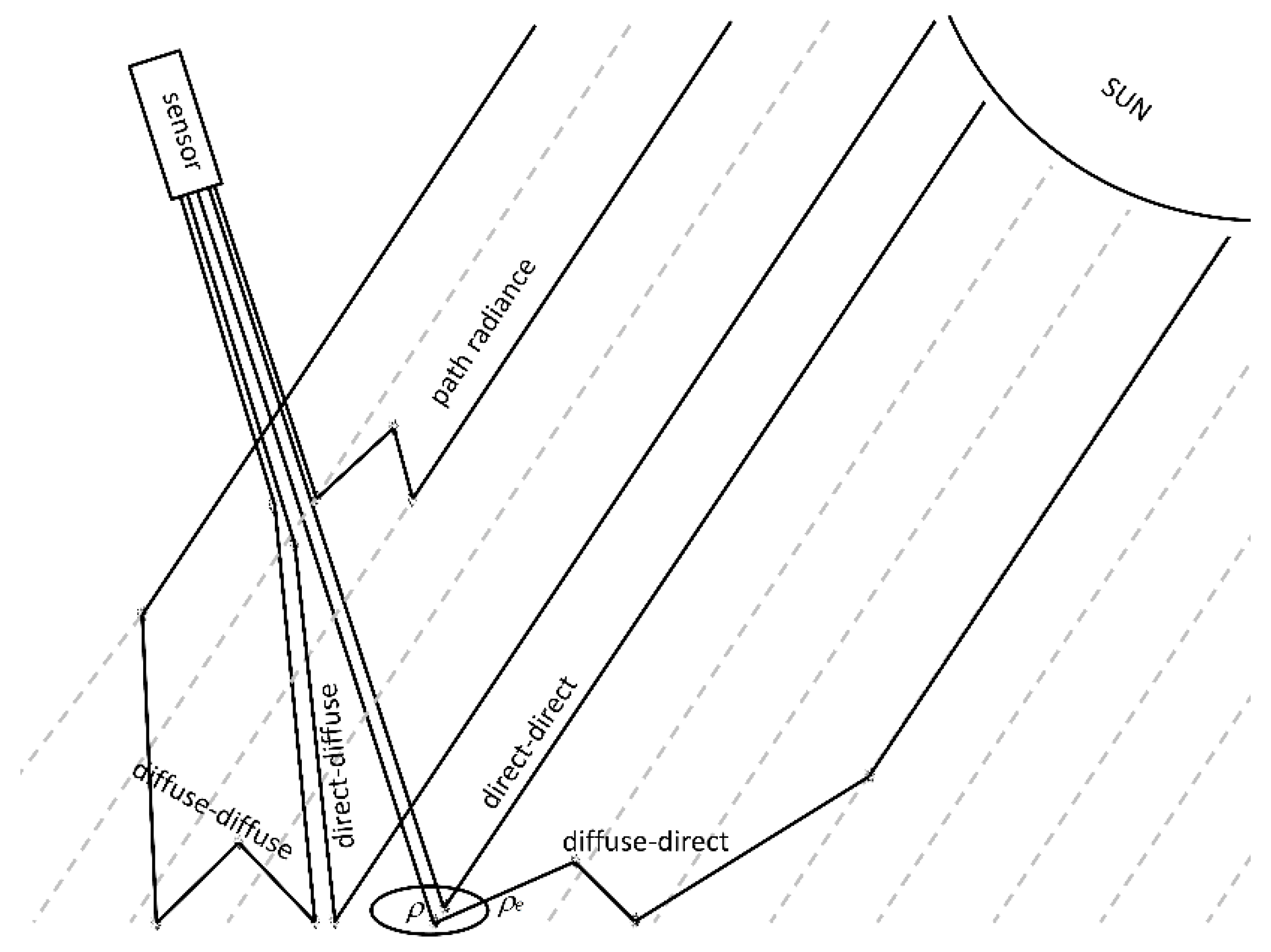
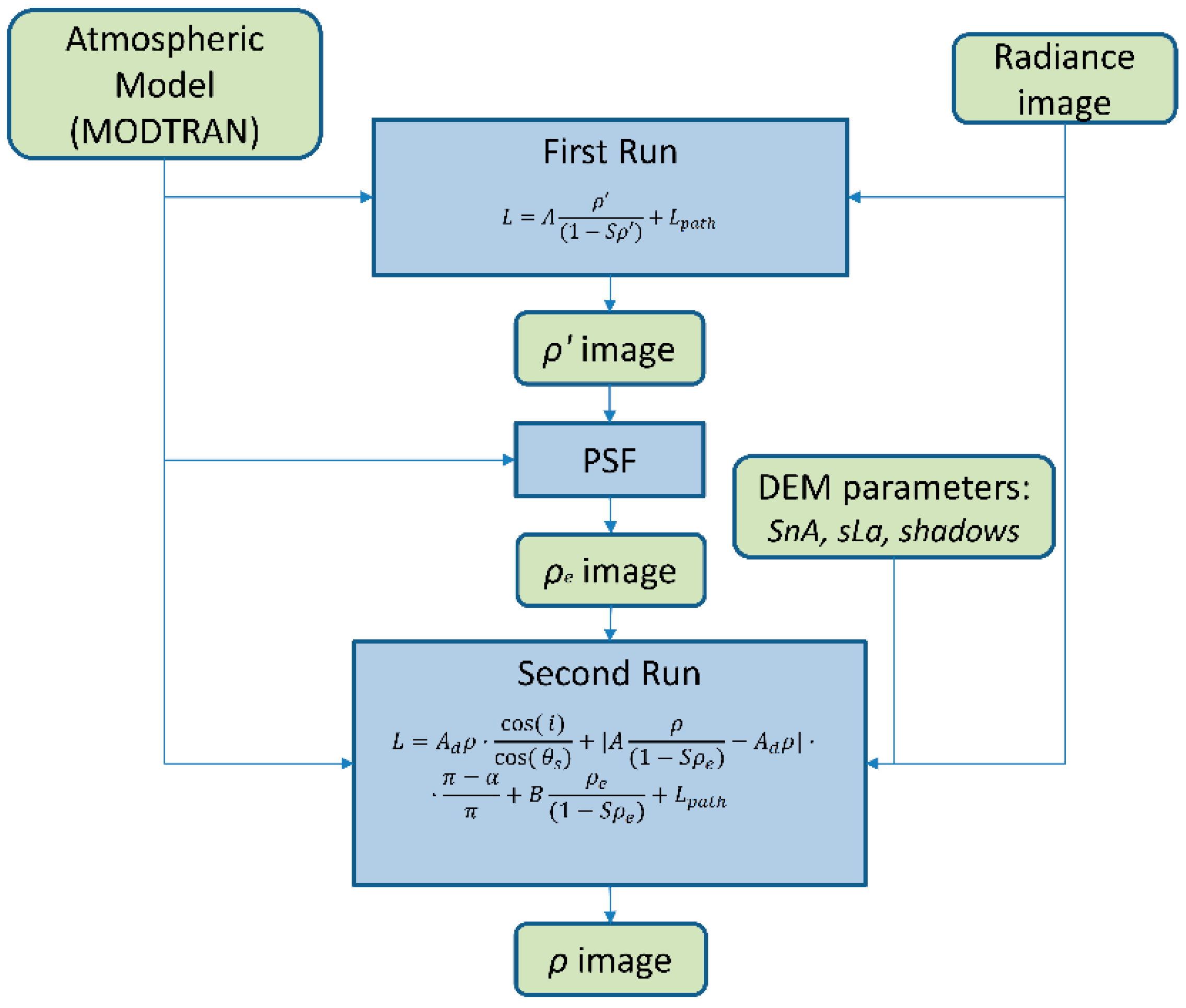




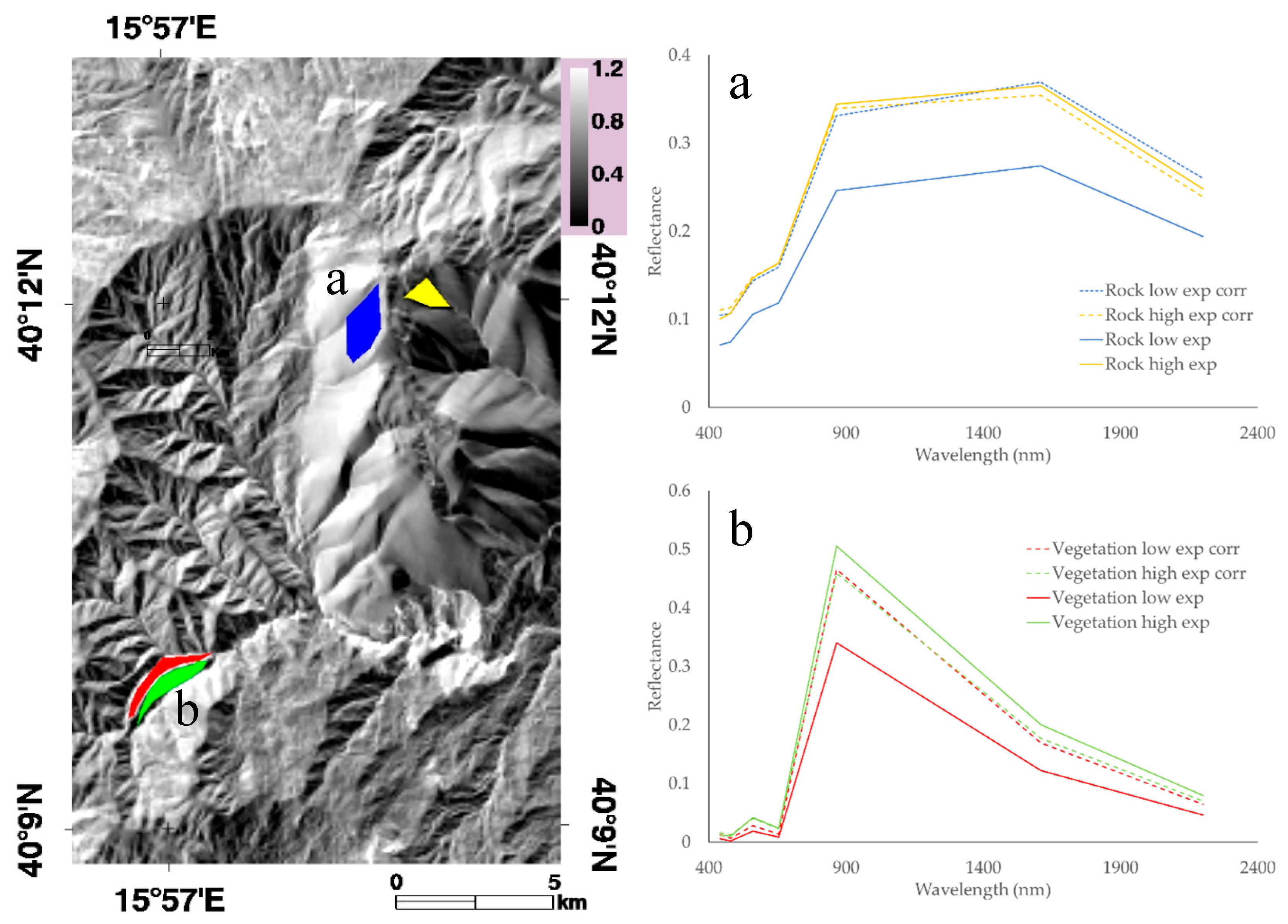
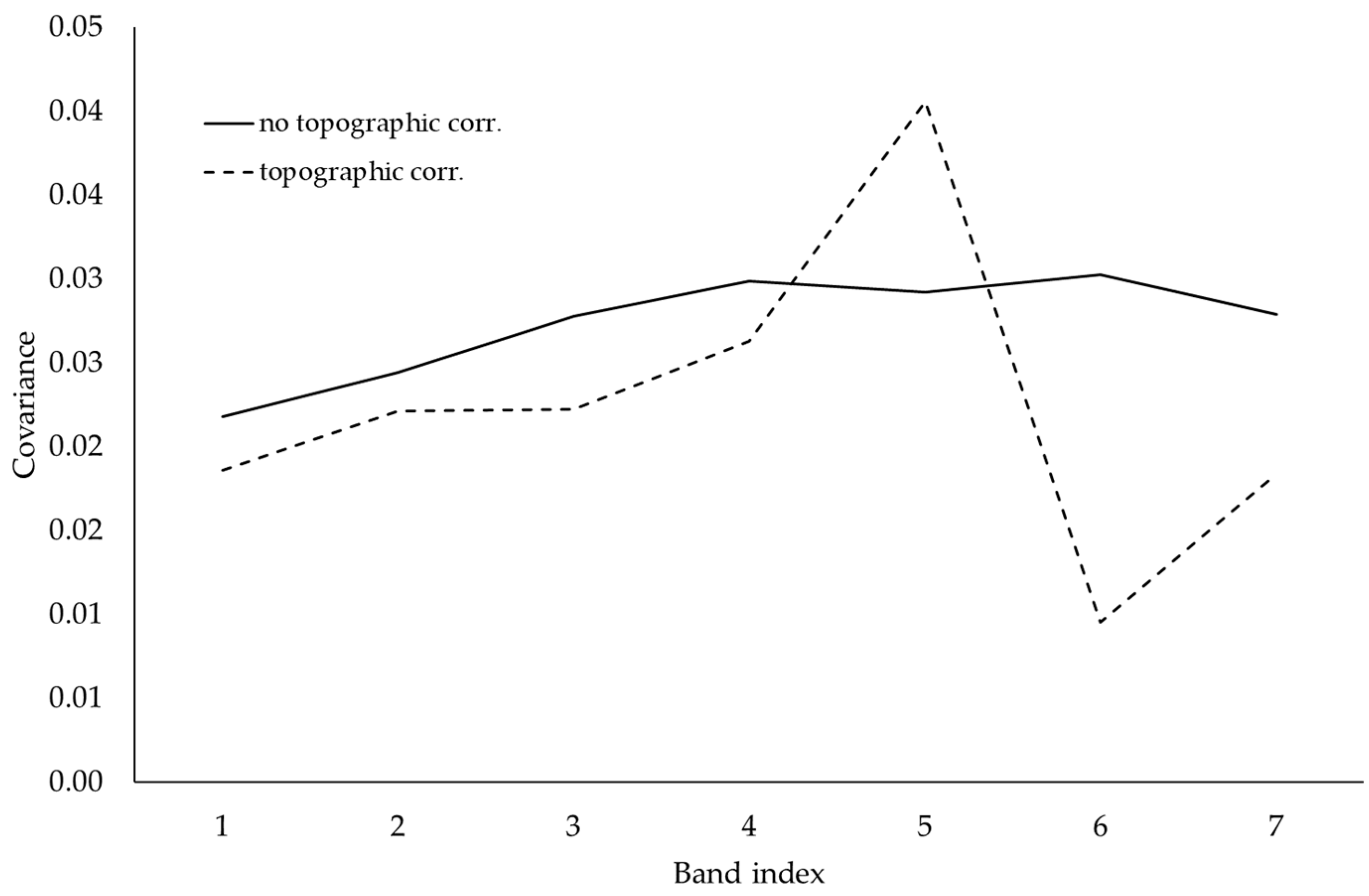



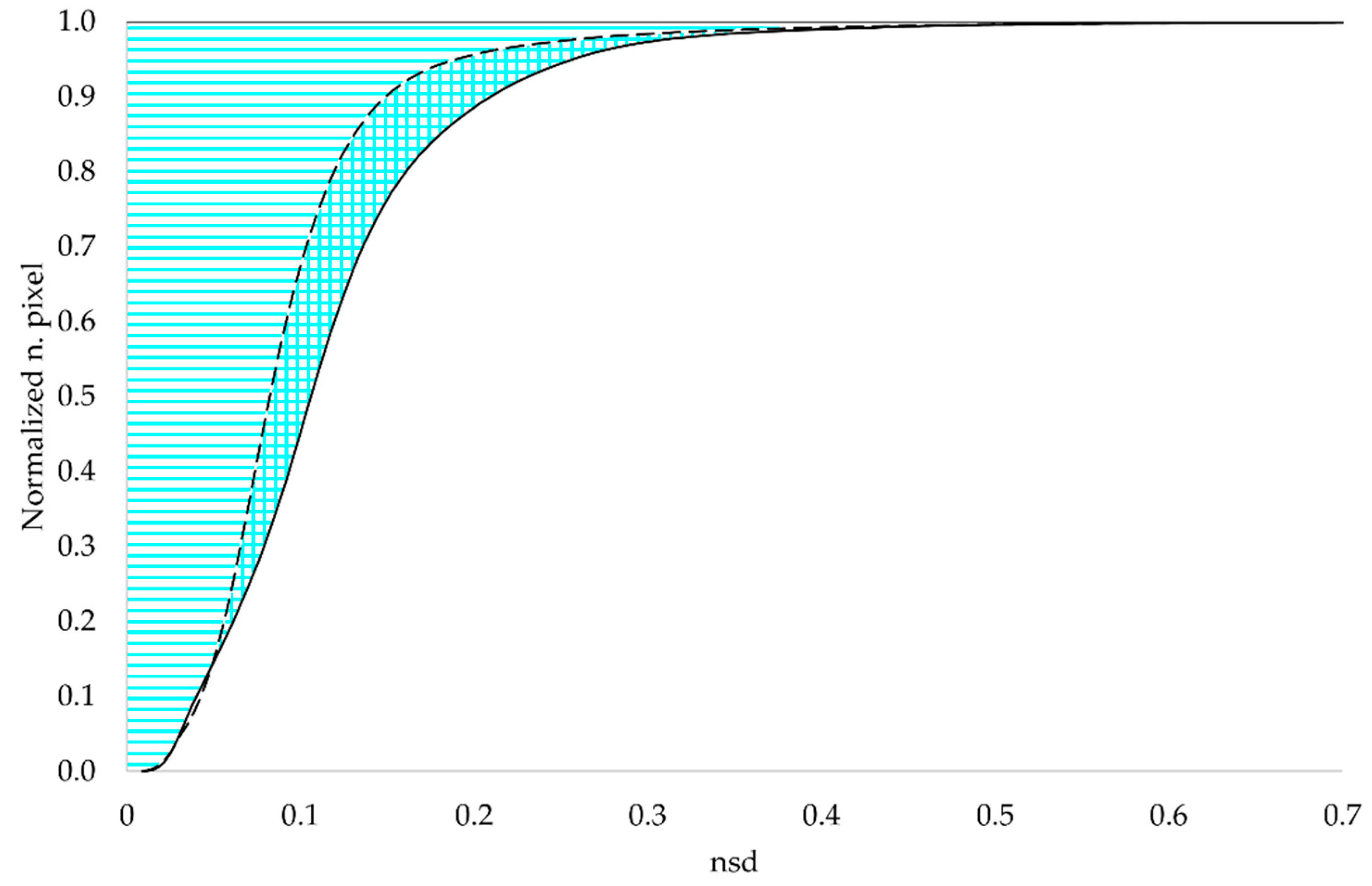
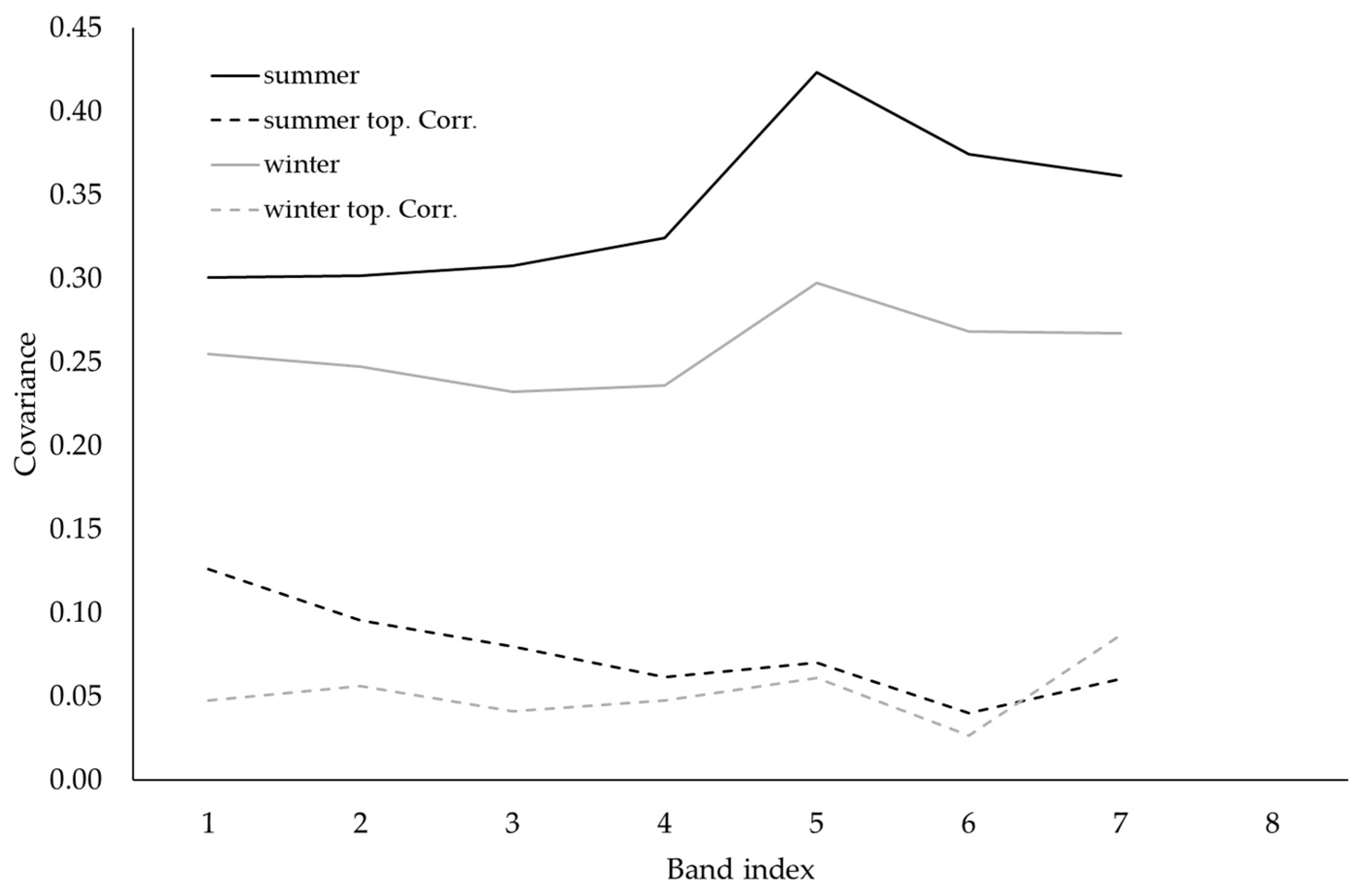

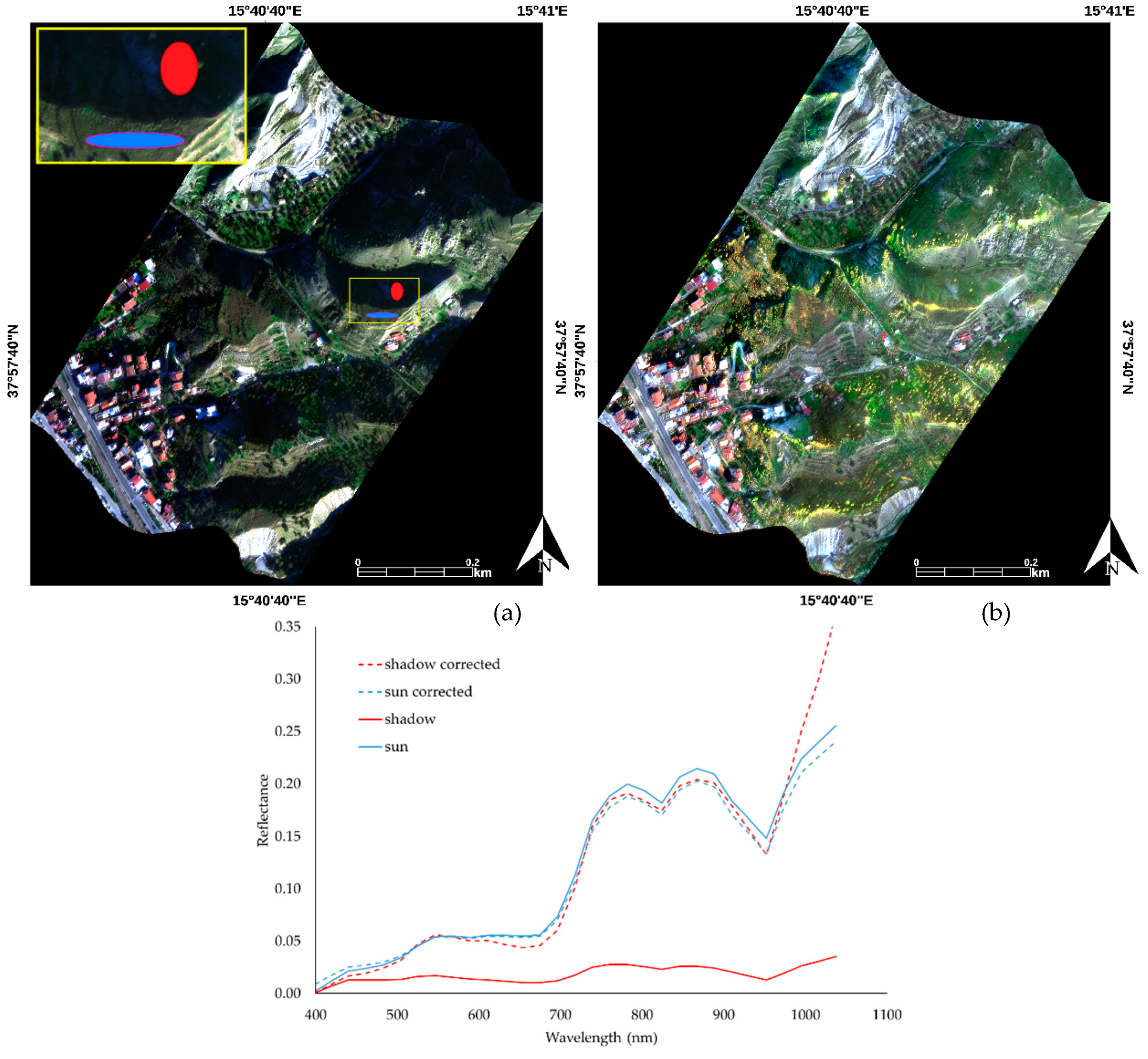
| MODTRAN Output Column (Output File Rootname.7sc) | MODTRAN Input Parameters (Input File Rootname.5tp) | Simulated Physical Quantity |
|---|---|---|
| GRND RFLT | SURREF≠0 in CARD 1 | Direct–direct + diffuse–direct contributions |
| DRCT RFLT | SURREF≠0 in CARD 1 | Direct–direct contribution |
| SOL SCAT | SURREF≠0 in CARD 1 | Direct–diffuse + diffuse–diffuse contributions + path radiance |
| SOL SCAT | SURREF=0 in CARD 1 | Path radiance (Lpath) |
| Veg. 1 | Veg. 2 | Grassland | Rock | Veg.1 | Veg.2 | Grassland | Rock | |
|---|---|---|---|---|---|---|---|---|
| Bands | no Topographic Correction | Topographic Correction | ||||||
| 1 (440 nm) | 0.006 | 0.006 | 0.010 | 0.021 | 0.005 | 0.005 | 0.009 | 0.020 |
| 2 (480 nm) | 0.007 | 0.006 | 0.010 | 0.021 | 0.006 | 0.005 | 0.010 | 0.020 |
| 3 (560 nm) | 0.009 | 0.010 | 0.011 | 0.024 | 0.009 | 0.009 | 0.012 | 0.021 |
| 4 (655 nm) | 0.011 | 0.009 | 0.017 | 0.026 | 0.010 | 0.008 | 0.017 | 0.023 |
| 5 (865 nm) | 0.033 | 0.039 | 0.039 | 0.043 | 0.031 | 0.042 | 0.033 | 0.045 |
| 6 (1610 nm) | 0.024 | 0.023 | 0.026 | 0.041 | 0.023 | 0.026 | 0.026 | 0.035 |
| 7 (2200 nm) | 0.015 | 0.014 | 0.021 | 0.034 | 0.015 | 0.015 | 0.021 | 0.030 |
© 2019 by the authors. Licensee MDPI, Basel, Switzerland. This article is an open access article distributed under the terms and conditions of the Creative Commons Attribution (CC BY) license (http://creativecommons.org/licenses/by/4.0/).
Share and Cite
Santini, F.; Palombo, A. Physically Based Approach for Combined Atmospheric and Topographic Corrections. Remote Sens. 2019, 11, 1218. https://0-doi-org.brum.beds.ac.uk/10.3390/rs11101218
Santini F, Palombo A. Physically Based Approach for Combined Atmospheric and Topographic Corrections. Remote Sensing. 2019; 11(10):1218. https://0-doi-org.brum.beds.ac.uk/10.3390/rs11101218
Chicago/Turabian StyleSantini, Federico, and Angelo Palombo. 2019. "Physically Based Approach for Combined Atmospheric and Topographic Corrections" Remote Sensing 11, no. 10: 1218. https://0-doi-org.brum.beds.ac.uk/10.3390/rs11101218




